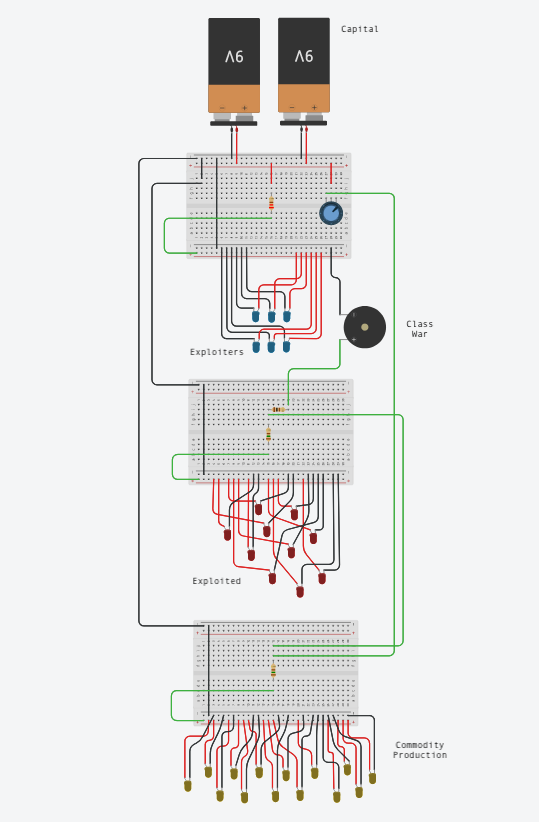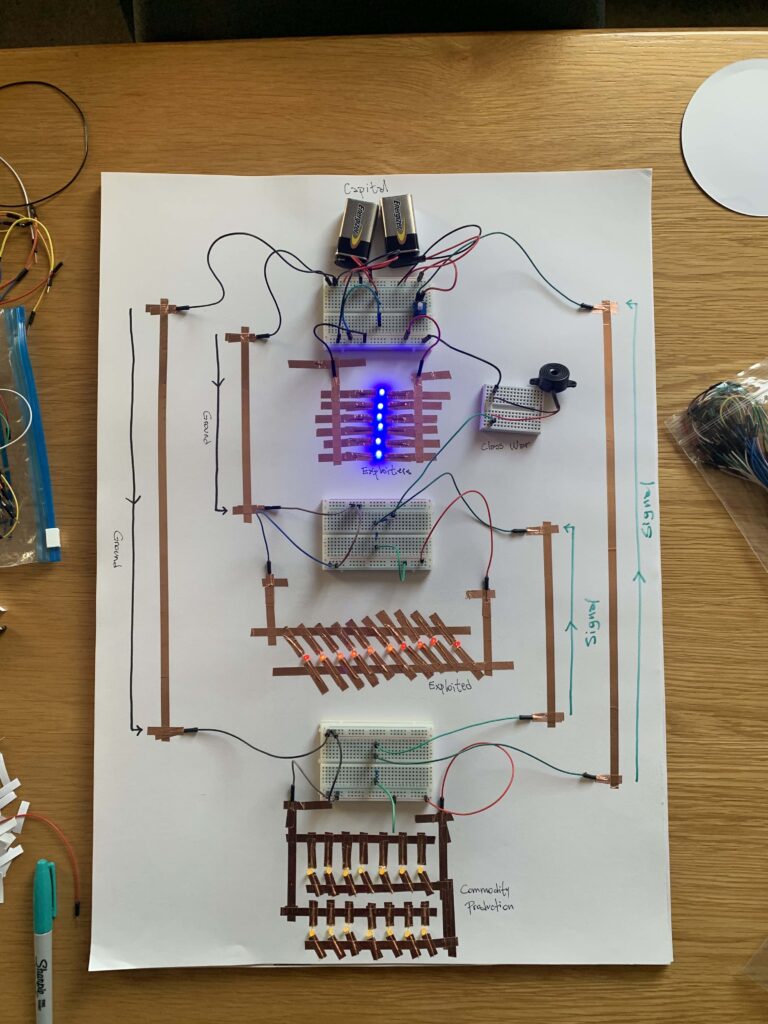For some time now, I have been working with what I call techno-diagrammatics. This notion is the product of my study of an old, unpublished manuscript that Stafford Beer developed during his last visit to Chile in June-July 1973; a document in which he attempted to model the dynamics of contemporary capitalism, and which I had access to thanks to the generosity and support of the former operations director of Project Cybersyn, Raul Espejo. The manuscript consists of two parts, the central element of which is a hand-drawn diagram (I am referring to and presenting only a small portion of it here). Beer’s main argument there was that the most powerful way to counterbalance the dynamics of contemporary capitalism was to update Marxism through cybernetics. In this sense, he used the language of electrical engineering to outline a general model of contemporary societies that simultaneously criticizes and praises (other kinds of) Marxism.

As one might expect, the result is provocative. Very few people have had access to this document, and some of them have reacted with either skepticism or criticism. In her book Cybernetic Revolutionaries, scholar Eden Medina mentions the manuscript and the model, stating that Beer’s use of the language of electrical engineering “makes no sense” and that his discussion of Marxism may be “lacking” (2011, p. 199-200). Later, when I presented and explained the model in Berlin over a year ago, the computer science researcher Stefan Höltgen became annoyed and claimed that – I am paraphrasing from memory here – Beer had no idea how to build an electrical circuit. I could not agree more. At the same time, however, I think that these are not the issues at stake here. Instead, I would argue that a document like this one invites us to ask quite different questions; for example, why did Beer proclaim that cybernetics could update Marxism and thus serve as a platform to counterbalance contemporary capitalism? Why did Beer choose the symbology of electrical engineering to unfold his proposal diagrammatically? And, perhaps more importantly, what would be both the media-archaeological and media-genealogical relevance of such an undertaking?
Convinced of the potential of these questions, I decided to undertake an experimental and somewhat speculative media archaeological analysis of Beer’s techno-diagram. Two inputs had a major influence on this decision. First, while participating in the online workshop “Diagram Diversity in the Light of Digital Humanities” organized by the Max Planck Institute for the History of Knowledge in November 2021, I recall repeatedly hearing the argument – I am also recalling from memory here – that the history of diagrams, and of the knowledge they carry and activate, is one of repetition and correction; that is, that deciphering or clarifying the initial impulse of scientific diagrams has often required subsequent modifications. Second, in a seminar taught by Wolfgang Ernst in the summer of 2019, I became acquainted with the work of the US ecologist H.T. Odum, in which he modeled ecological systems using “passive electrical analogs.” At this point, I wondered if an approach similar to Odum’s, perhaps a more experimental one, could be used to analyze, update, and thus assess the extent of Beer’s techno-diagram.
Thanks to Sebastian Kawanami-Breu’s invitation, since last year I have been working on it once a week at the Signal Lab of Humboldt University. In the first phase, I have focused my efforts on a part of Beer’s diagram (layer one), where he models Marx’s general propositions on the operations that would have (in)formed modern societies under the influx of capitalism. At the same time, my initial goal was to find ways to activate this section of the diagram as an actual circuit; that is, so that the electrical flow could actually circulate consistently and operate the actuators placed there. More importantly, perhaps, was the question of how the actors Beer included in his techno-diagram could be represented by electrical components. As the image above shows, the Exploiters, the Exploited Class, and Commodity Production are represented by LEDs, where light and its brightness play an important role. Similarly, the Class War between the Exploiters and the Exploited Class is represented by a piezoelectric, whose sound and volume also play an important role in the diagram. The image above also shows that I started with a digital simulation. I tried a few programs for this and I finally came to TinkerCAD. This platform, because of its versatility and its live simulation tool, is the one that best fits the needs of my experimental process.

Once I was able to get the circuit working properly, the next step was to implement it in the real world. The image and video below give you an idea of the first material sketch (be aware of the audio in the video, which can be a bit annoying). Similar to another project I have been working on, there were a lot of frictions in this transition. Some actuators didn’t work as consistently as the simulation showed, and the material used to implement the connections required of several iterations. After a couple of days, however, things started to work well and the material sketch functioned as a proper techno-diagram, in the sense that I conceive the term.

In a few weeks I will update this post, probably with a separate entry. My aim there will be to show that the very process of producing this sketch – first as a digital simulation, then as a material circuit – has provided me with very interesting, albeit preliminary, insights into assessing both the media archaeological and media genealogical relevance of Beer’s “Cybernetic Model of Contemporary Capitalism.” Similarly, I will explain how this experimental and speculative process also seems to suggest that the notion of techno-diagrammatics has a promising scope both as an object of inquiry and as a research method. But first, I’m going to present these findings in a couple of forums, where I’m hoping to get insights that can help my process and these short posts.
Before closing, I would like to add that in a recent article Raul Espejo (2022, p. 1175) has referred to Beer’s model and outlined its scope. Similarly, I have written a paper explaining the techno-diagram in detail (all its layers and interactions), which I hope to publish relatively soon. In the meantime, this series of post is intended to provide an initial introduction to the topic, the case, and the approach I’m developing.
[Update: You can now read the second part of this post here]
Berlin-Mitte, April 2023.